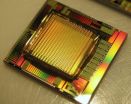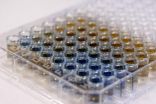(Press-News.org) Fast and ultrasensitive optical systems are gaining increasing significance and are being used in a diverse range of applications, for example, in imaging procedures in the fields of medicine and biology, in astronomy and in safety engineering for the automotive industry. Frequently the challenge lies in being able to record high-quality images under extremely low light conditions. Modern photo detectors for image capture typically reach their limits here. They frequently work with light-sensitive electronic components that are based on CMOS (Complementary Metal Oxide Semiconductor) or CCD (Charge-Coupled Device) image sensors. The problem is that neither the latest CMOS nor CCD systems can simultaneously guarantee a swift and highly-sensitive high quality image recording if there is a paucity of photons to read.
In cooperation with the partners of the MiSPiA project consortium the Fraunhofer Institute for Microelectronic Circuits and Systems IMS in Duisburg has now advanced the development of CMOS technology and introduced an ultrasensitive image sensor with this technology, based on Single Photon Avalanche Photodiodes (SPAD). Its pixel structure can count individual photons within a few picoseconds, and is therefore a thousand times faster than comparable models. Since each individual photon is taken into consideration camera images are also possible with extremely weak light sources.
Camera installed directly on chip
To achieve this the new image sensor uses the "internal avalanche breakdown effect"– a photoelectric amplification effect. The number of "avalanche breakdowns" corresponds to the number of photons that the pixels hit. In order to count these events, each of the sensor's pixels comes with very precise digital counters. At the same time, the scientists have applied microlenses to each sensor chip, which focus the incoming beam in each pixel onto the photoactive surface. Another advantage is that processing the digital image signals is already possible directly on the microchip; therefore, additional analogue signal processing is no longer needed.
"The image sensor is a major step toward digital image generation and image processing. It allows us to have the capability to use even very weak light sources for photography. The new technology installs the camera directly on the semiconductor, and is capable of turning the information from the light into images at a significantly faster pace," states Dr. Daniel Durini, group manager for optical components at the Fraunhofer Institute IMS.
IMS engineered the sensor under the European research project MiSPiA (Microelectronic Single-Photon 3D Imaging Arrays for low-light high-speed Safety and Security Applications). Altogether, seven partners throughout Europe from the fields of research and business are involved in the project. In the next stage, the scientists from Duisburg are working on a process to produce sensors that are back-lighted, and in this regard, even more powerful. At the same time, the new technology is already being utilized in tests for traffic. Chip-based mini-cameras protect vehicles, bicycles and pedestrians from collisions and chip-based accidents, or assist in the reliable functioning of safety belts and airbags.
INFORMATION:
The Fraunhofer Institute IMS will exhibit the new image sensor at "Vision" – the world's leading trade show for image processing – from November 6 to 8, 2012 in Stuttgart at stand H74 in Hall 1.
Ultrasensitive photon hunter
2012-11-07
ELSE PRESS RELEASES FROM THIS DATE:
Dealing with power outages more efficiently
2012-11-07
Power supply is the backbone of our modern economy. Nearly every aspect of life depends on electrically-operated devices. When the flow of power stops, it is not just the lights that go out. In the supermarket, the automatic teller machines and cash registers stop working. Even telephones, radios and televisions become paralyzed. If the shortage lasts a long time the supply of hot water, gas and fuel and the functioning of respirators at intensive care units in nursing homes or at private homes is at risk.
The causes of this dreadful scenario can range from natural disasters ...
Activating the 'mind's eye' -- sounds, instead of eyesight can be alternative vision
2012-11-07
Jerusalem, Nov. 7, 2012 -- Common wisdom has it that if the visual cortex in the brain is deprived of visual information in early infanthood, it may never develop properly its functional specialization, making sight restoration later in life almost impossible.
Scientists at the Hebrew University of Jerusalem and in France have now shown that blind people – using specialized photographic and sound equipment – can actually "see" and describe objects and even identify letters and words.
The new study by a team of researchers, led by Prof. Amir Amedi of the Edmond and ...
Protected areas in East Africa may not be conserving iconic plants
2012-11-07
A new study led by researchers from the University of York suggests protected areas in East Africa are not conserving plants such as the iconic Acacia tree.
Acacia, the thorny flat-topped tree that characterises the African savannas, is an important component of ecosystem diversity. However, the researchers found that the majority of Acacia biodiversity 'hotspots' receive little protection through the protected area network, which includes national parks, nature and forest reserves. The situation, they say, may be exacerbated by climate change.
The results of the study, ...
Development of measures to prevent wine indispositions
2012-11-07
Biogenic amines may be one of the factors responsible for symptoms such as headaches, gastro-intestinal disorders, shortness of breath, fall in blood pressure, and even unconsciousness and cardiac arrhythmia in severe cases. Histamine, one of the best known members of this group, can cause serious physical problems. Biogenic amines can be produced in the body by natural metabolic activities but are also ingested in larger quantities with food. They play a special role in microbiologically produced food such as wine, beer, cheese, and sauerkraut. In a joint project Johannes ...
Recent studies bring fossils and genes together to piece together evolutionary history
2012-11-07
Paleontology, with its rocks and fossils, seems far removed from the world of developmental genetics, with its petri dishes and embryos. Whereas paleontology strives to determine "What happened in evolution?", developmental genetics uses gene control in embryos to try to answer "How did it happen?" Combined, the two approaches can lead to remarkable insights that benefit both fields.
In the current issue of the Journal of Vertebrate Paleontology, Hans Thewissen, Ingalls-Brown Professor at Northeast Ohio Medical University (NEOMED), and his colleagues review recent studies ...
New method could help communities plan for climate risk
2012-11-07
CAMBRIDGE, Mass. -- Climate scientists cannot attribute any single weather event — whether a drought, wildfire or extreme storm — to climate change. But extreme events, such as Hurricane Sandy, are glimpses of the types of occurrences the world could be more vulnerable to in the future. As the devastation left by Sandy continues to reverberate, decision-makers at every level are asking: How can we be better prepared?
MIT researchers have developed a new tool to help policymakers, city planners and others see the possible local effects of climate change. Its regional projections ...
Synthetic biofilter wins through to the top 'Sweet 16' in Boston
2012-11-07
This press release is available in German.
Months of painstaking work in the laboratory at Bielefeld University's Center for Biotechnology (CeBiTec) have paid off: the 15 students participating in this year's 'international Genetically Engineered Machine competition' (iGEM) at the Massachusetts Institute of Technology (MIT) have good reason to celebrate. The goal of their project was to develop a biological filter that removes estrogen from drinking water. It was a success: they managed to produce enzymes that break down the hormone. On Monday 5 November, the competition ...
Longer use of hormonal contraception during midlife predicts better cognitive function later
2012-11-07
New Rochelle, NY, November 7, 2012—Premenopausal use of hormonal contraceptives may improve the cognitive abilities of women in midlife and for years afterward. This finding may have implications for prevention of declining cognitive function that occurs with advancing age and in diseases such as Alzheimer's. The beneficial effects of hormones increase the longer a woman uses them, as described in a study published in Journal of Women's Health, a peer-reviewed publication from Mary Ann Liebert, Inc., publishers. The article is available free on the Journal of Women's Health ...
Teva to present new Phase III data for QNASL® Nasal Aerosol at the 2012 ACAAI Meeting
2012-11-07
Contact: Denise Bradley
denise.bradley@tevapharm.com
215-591-8974
Teva North America
Teva to present new Phase III data for QNASL® Nasal Aerosol at the 2012 ACAAI Meeting
Studies highlight safety and efficacy profiles in pediatric patients with seasonal allergic rhinitis, reinforce device functionality and reliability and demonstrate ocular safety profile
JERUSALEM, Israel, November 6, 2012 – Teva Pharmaceutical Industries Ltd. announced today that additional data from the Phase III clinical program for QNASL® (beclomethasone dipropionate) Nasal Aerosol will be ...
Bone marrow stem cells do not improve short-term recovery after heart attack
2012-11-07
HOUSTON – (Nov. 7, 2012) – Administering stem cells derived from patients' own bone marrow either three or seven days after a heart attack is safe but does not improve heart function six months later, according to a clinical trial supported by the National Institutes of Health (NIH).
The results of the trial, called Transplantation In Myocardial Infarction Evaluation (TIME), mirror a previous related study, LateTIME, which found that such cells (called autologous stem cells) given two to three weeks after a heart attack did not improve heart function. Both TIME and LateTIME ...





